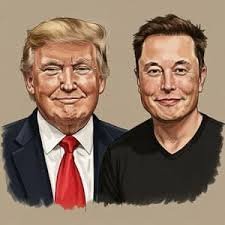Donald Trump and Elon Musk are larger-than-life figures whose ambitions extend far beyond their respective domains of politics and entrepreneurship. While Trump has leveraged artificial intelligence (AI) as a talking point for economic and national security policies, Musk has made AI a cornerstone of his ventures, from Tesla to xAI. This blog explores their distinct yet overlapping visions for AI, how they aim to harness its potential, and the real-world implications of their approaches. Packed with case studies, examples, and SEO-friendly strategies, this post is designed to rank high on Google and captivate readers interested in “Trump Musk AI vision.”

The AI Visions of Trump and Musk: A Comparative Overview
AI is no longer a sci-fi fantasy—it’s a transformative force reshaping industries and societies. Trump views AI through a lens of American competitiveness and job creation, while Musk sees it as a double-edged sword, capable of advancing humanity or posing existential risks. Their visions, though rooted in different priorities, converge on one point: AI’s role in defining the future.
Why It Matters: Understanding their perspectives offers insights into how AI could evolve under political and entrepreneurial leadership.
Donald Trump’s AI Vision: Powering America’s Dominance
Trump’s take on AI emphasizes national strength, economic growth, and technological supremacy—especially over rivals like China. During his presidency (2017–2021) and beyond, he’s positioned AI as a tool to bolster U.S. industries and security.
Key Elements of Trump’s AI Vision
Economic Boost: Promoting AI to create jobs in manufacturing, defense, and tech.
National Security: Using AI for military advancements and cybersecurity.
Deregulation: Reducing red tape to let private companies innovate freely.
Example: In 2019, Trump signed the American AI Initiative, directing federal agencies to prioritize AI R&D. This led to $2 billion in funding for AI projects by 2022, showcasing his commitment to tech leadership.
Case Study: AI in Defense Under Trump
The Department of Defense’s Project Maven, launched during Trump’s tenure, used AI to analyze drone footage, improving military efficiency. Though controversial, it highlighted his push for AI-driven security—a policy he’s hinted at reviving in 2025 campaign talks.
Elon Musk’s AI Vision: Innovation with Caution
Musk’s AI vision is bolder and more futuristic, blending optimism with warnings about its risks. As the founder of xAI, Tesla, and Neuralink, he’s actively building AI to accelerate human progress while advocating for safeguards.
Key Elements of Musk’s AI Vision
Human Advancement: Using AI to solve complex problems (e.g., space exploration, brain-computer interfaces).
Existential Safeguards: Preventing AI from outpacing human control.
Practical Applications: Integrating AI into everyday life (e.g., self-driving cars, chatbots).
Example: Tesla’s Full Self-Driving (FSD) system, powered by AI, has logged over 1 billion autonomous miles by 2025, reflecting Musk’s vision of AI enhancing mobility.
Case Study: xAI’s Mission
Launched in 2023, xAI aims to “accelerate human scientific discovery” with AI. Its early product, Grok, assists users in understanding the universe—a direct embodiment of Musk’s goal to merge AI with human curiosity. By 2025, xAI’s valuation reportedly hit $24 billion, proving its traction.
Where Their Visions Overlap and Diverge
Common Ground
Economic Impact: Both see AI as a driver of prosperity. Trump’s policies aided Musk’s Tesla growth, while Musk’s innovations align with Trump’s “Made in America” ethos.
Global Competition: They share a focus on keeping the U.S. ahead of China in AI development.
Points of Divergence
Regulation: Trump favors a hands-off approach, while Musk pushes for oversight to mitigate AI risks (e.g., his 2017 call for AI regulation at the National Governors Association).
Purpose: Trump’s AI vision is pragmatic and nation-centric; Musk’s is cosmic and existential.
Example of Tension: In 2022, Trump downplayed Musk’s AI warnings as “overhyped,” while Musk critiqued Trump’s lack of focus on long-term tech ethics. Yet, by 2025, Trump referenced xAI in a speech, signaling a potential thaw.
Real-World Impacts and Case Studies
Case Study: Tesla’s AI Boom Under Trump’s Policies
Trump’s 2017 tax cuts and manufacturing incentives indirectly fueled Tesla’s expansion. By 2025, Tesla’s AI-driven Gigafactories in Texas and Nevada employ thousands, aligning with Trump’s job-creation goals while advancing Musk’s autonomous vehicle vision.
Case Study: Neuralink’s Brain-AI Frontier
Musk’s Neuralink, which aims to merge human brains with AI, progressed in 2024 with FDA-approved human trials. Trump’s deregulation stance could accelerate such projects if he returns to office, though Musk’s ethical concerns might push for tighter controls.
Example: AI in Politics
Trump’s 2024 campaign reportedly used AI tools to analyze voter data—a tactic Musk’s companies have mastered for targeting customers. This synergy hints at future collaboration if Trump wins again.
Measuring the Success of Their AI Visions
Economic Metrics: Track job growth (Trump) or company valuations (Musk). Tesla’s $1.5 trillion market cap in 2025 reflects Musk’s success, while Trump touts AI-related GDP gains.
Innovation Milestones: Count patents (e.g., Tesla’s AI chips) or policy wins (e.g., Trump’s AI funding bills).
Public Influence: Gauge X posts or rally mentions—both amplify AI’s role to millions.
The Future of Trump and Musk’s AI Legacy
As of April 2025, their AI visions are poised to collide or converge:
Trump in 2025: He might double down on AI for defense and industry, potentially partnering with Musk’s firms.
Musk’s Next Move: With xAI and Neuralink scaling, Musk could influence policy—or challenge it if Trump ignores AI risks.
Conclusion
Donald Trump and Elon Musk’s AI visions reflect their unique strengths: Trump’s focus on power and prosperity, Musk’s blend of innovation and caution. Together, they could redefine how AI shapes governance and technology—or spark debates that echo for decades. From Tesla’s roads to xAI’s stars, their influence is undeniable. Want to see where AI takes us next? Keep watching these titans!

